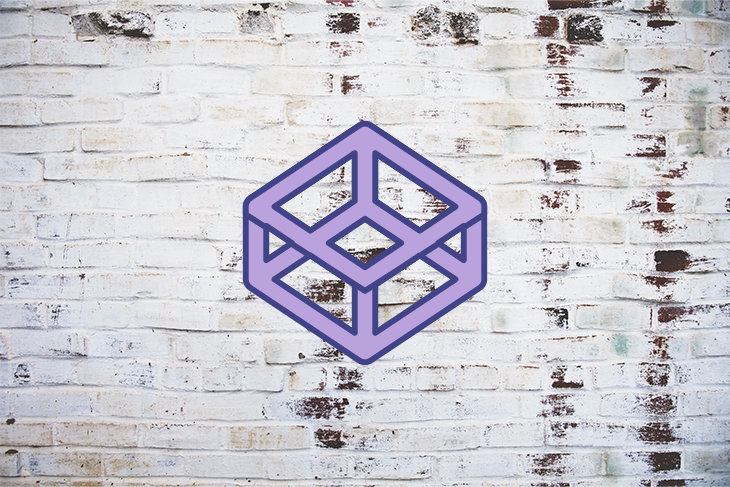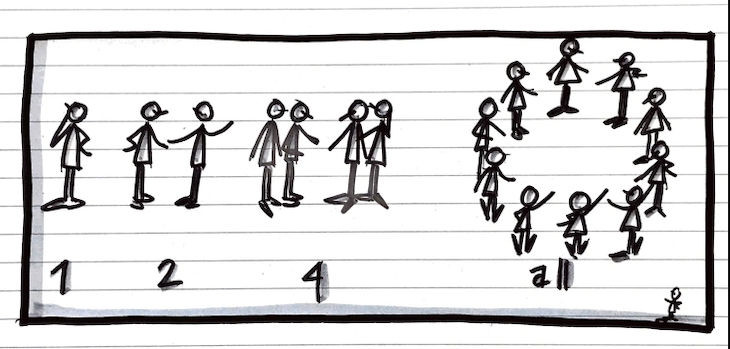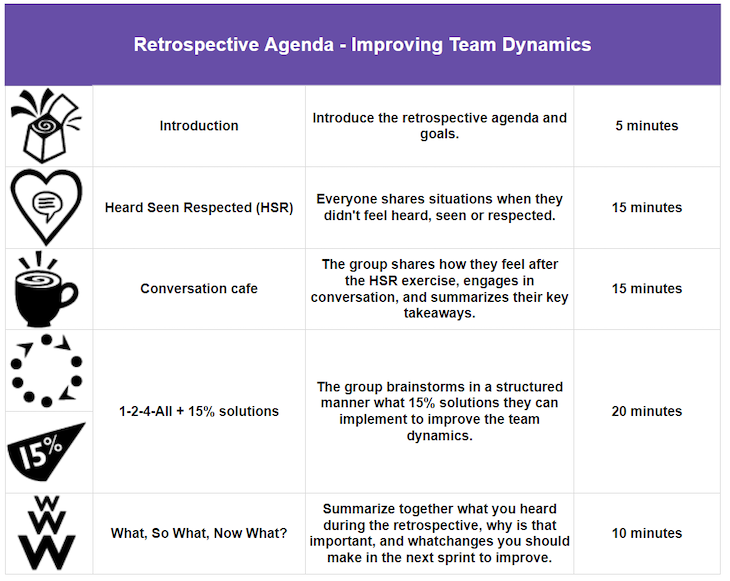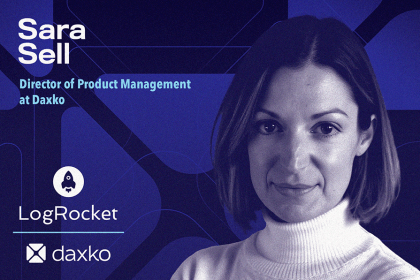There’s hardly a better tool to improve team dynamics and effectiveness than a well-run retrospective.

Yet, retrospectives easily fall into a repetitive trap of adding “what went well” and “what went bad” sticky notes and vaguely discussing potential action points.
Let’s explore how we can make retrospectives engaging and productive by employing one of the most potent facilitation tools: Liberating Structures.
In simple terms, Liberating Structures is a set of facilitation techniques that can be used to lead productive workshops. They are focused on getting the most out of the collective knowledge and thoughts of the group and go beyond standard formats such as brainstorming and moderated discussions.
There are 34 structures in total. However, with the ability to mix up and combine various structures, the possibilities are endless.
A sprint retrospective can be the most powerful meeting of an agile team. If facilitated well, it allows the team to improve its effectiveness, resolve conflicts before they happen, and help everyone excel.
However, facilitating a retrospective session is often harder than it seems. Many people fall into the same repetitive structure:
While there’s nothing wrong with the approach itself, the problem appears when this format is repeated over and over again. People quickly get used to it and get bored, and the meeting no longer forces the team to think deeply about improving its processes.
An effective retrospective:
Because Liberating Structures are designed to achieve just that, they are an excellent fit for creating engaging retrospective agendas.
Let’s explore a few examples of how you can use Liberating Structures during your next retrospective. Refer to this library whenever you design a retrospective for fresh inspiration.
1-2-4-All is a fundamental Liberating Structure that works both as a standalone technique or as a part of other structures.
This structure is a combination of silent brainstorming, discussions, and open discussion.
Start with a question, such as “how can we solve issue X?” or “what problem should we focus on next?” Give people approximately two minutes to think alone on their own. Then, let them discuss in pairs for another few minutes and, ideally, agree on one point. Then, proceed to groups of four:

At the very end, each group should have shared its conclusions with the rest of the team. For smaller teams, you can reduce the technique to 1-2-all and skip the group parts.
In a short time, the 1-2-4-all structure allow people to think on their own (which is often the most productive thinking) and engage everyone in conversation (you can’t sit quietly during 1-1 conversation). By refining and discussing in groups, you can effectively filter the most promising ideas.
This technique is most effective when either defining a problem to focus on or ideating possible solutions for a problem. That said, you can also keep it more open.
Once, I ran a 1-2-4-all exercise with a very open-ended question: “What’s the one thing we can start doing from the next sprint to improve?” Believe it or not, the results were great.
Some problems seem impossible for the team to solve, especially if they relate to how the company works as a whole. The goal of 15 percent solutions is to break that status-quo thinking by looking for small actions within the team’s possibilities.
Start with an opening question, such as:
Encourage people to ideate as many possibilities as they can. Give them the first 5 minutes to ideate alone, then combine them in groups. Note down the most prominent ideas.
This structure challenges the status quo. Teams often have multiple challenges that seem completely out of their control. But even externalities can often be improved to some extent.
Instead of focusing on the problem as a whole, thinking about more minor improvements that the team can implement on their own opens new ideas and creativity.
Use 15% solutions when you’re dealing with problems and challenges that initially seem unsolvable by the team alone.
Some problems simply require an open conversation. The conversation cafe method facilitates just that, but it also gives a lightweight structure that helps engage everyone and foster a safe environment.
Start by explaining and discussing conversation cafe agreements. That is:
Even though it might seem fluffy, a quick recap of these points does help to frame people’s thinking and approach.
Then, proceed with a four-step process:
You might also invite an external facilitator to help maintain the flow and hold people accountable to the six agreements.
First of all, the conversation cafe approach gives everyone time to be heard and share their opinion in the beginning. These first two steps not only increase the chance that more people will join the open discussion, but also builds shared empathy and understanding of the problem.
Sticking to agreements helps keep the discussion meaningful and safe. The wrap-up at the end once again helps engage the quiet people in the room and maximizes the chance of leaving with meaningful takeaways.
Conversation cafe is a go-to technique when unpacking sensitive topics. It’s especially relevant for team conflicts or when the group goes through a challenging period.
However, the technique is flexible enough and can be used for almost any topic, even basic ideation.
TRIZ helps to unlock creativity and find things you should stop doing to achieve desired outcomes by naming undesirable behaviors.
Start with a provoking question, such as, “What can we do to achieve the worst imaginable outcome?” Work in small groups (or combine with 1-2-4-all or conversation cafe) to prepare a list of things you can do to achieve the worst result.
Then, assess the list as a group and ask yourselves, “Is there anything we are currently doing that resembles items from the list?”
Be brutally honest and prepare the second list. Go through items on the second list and prioritize which destructive behaviors you should stop doing to avoid the worst possible scenario.
The TRIZ technique opens your team up to a new way of thinking. While most retrospectives focus on implementing new features and adding new processes, TRIZ helps us step back, assess our way of working, and spot the bad things in our current process.
Honestly, in its wicked manner, TRIZ is quite a fun exercise!
Use Triz periodically to assess the health of the team’s processes. Prioritize this structure when you feel that the team is doing something wrong but can’t really name what it is. It also works as an excellent pre-mortem exercise and risk-definition exercise.
Heard, seen, respected (HSR) is a powerful technique to build shared understanding, cultivate team empathy, and improve team culture.
Set up pairs. In each pair, each participant openly shares a situation from when they didn’t feel heard, seen, or respected by others in the team. The participants then shares how they felt about hearing each other’s stories.
Next, split into small groups, share your thoughts, and identify patterns the stories reveal. Proceed with other structures or retrospective formats to unpack how to change these patterns.
HSR is one of few techniques that go deep into team dynamics and individuals’ feelings. It helps uncover problems that are hard or uncomfortable to share on a day-to-day basis.
HSR invites vulnerability, which helps to strengthen team relationships and build shared team empathy.
First of all, you should only use heard, seen, respected with mature teams that have worked with each other for a while. A proper HSR requires vulnerability and trust, which takes time to develop.
This structure works well as a periodic exercise (at least once a quarter), but you should prioritize it if you notice any toxic or inefficient dynamics within your team.
A proper retrospective wrap-up is as important as the retrospective as a whole. Even the deepest and most engaging retrospective is a waste of time if it doesn’t lead to any meaningful outcomes.
What3 debrief is a tool designed to ensure every workshop ends with some actionable next steps.
At the end of the retrospective, ask everyone these three sets of questions:
Then, capture any newly emerged insights and list possible action points.
The recap of the experience helps to solidify discussed topics and challenges. It also reveals how everyone perceived previous exercises, which helps to build empathy and understanding.
What3 enables you to sweep up any previously missed insights. Most importantly, it helps the team define actionable steps to improve iteratively following the retro.
Ideally, you’d use the What3 debrief model as a wrap-up for every retrospective.
While all Liberating Structures can be used as a standalone exercise, you can also combine them to build truly robust retrospectives.
For example, while conducting heard, seen, respected alone is already a powerful exercise, you lose a lot of potential if you don’t plan the next steps immediately.
Start small with one or two Liberating Structures per retrospective. As the team begins to understand them, consider combining multiple structures to drive even higher engagement and derive even more valuable outcomes.
An agenda for inspecting and improving team dynamics might look like this:
The success of a retrospective is all about facilitation. As a retrospective facilitator, it’s your responsibility to engage the whole team, create a safe environment, and help drive actionable outcomes. Liberating Structures is an excellent toolbox to achieve this. It helps build a better, more engaging retrospective that drives change and constant improvement.
A retrospective is the most potent tool you can use to improve team’s dynamics and effectiveness.
Make sure you get the most out of each one.
One of the easiest ways to dramatically improve retrospectives’ effectiveness if by employing Liberating Structures. With their help, you can design countless unique, tailor-made workshops to step up your game as a product team.
LogRocket identifies friction points in the user experience so you can make informed decisions about product and design changes that must happen to hit your goals.
With LogRocket, you can understand the scope of the issues affecting your product and prioritize the changes that need to be made. LogRocket simplifies workflows by allowing Engineering, Product, UX, and Design teams to work from the same data as you, eliminating any confusion about what needs to be done.
Get your teams on the same page — try LogRocket today.

Understanding your margin of error and confidence intervals helps you make solid product decisions and avoid costly mistakes.

By implementing an effective PDM system, you can foster collaboration, improve decision-making, and accelerate your time-to-market.

Sara Sell, Director of Product Management at Daxko, shares how she developed skepticism and curiosity from her time in teaching and research.

A well-defined customer discovery process serves as the foundation for building products that customers truly want.